Basilica di San Miniato al Monte – San Minjato al Monte bazilika
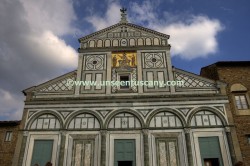 San Miniato al Monte bazilika įsikūrusi aukštai virš miesto ir yra vienas gražiausių romaninės architektūros pavyzdžių Toskanoje. San Miniato buvo pirmasis miesto kankinys, greičiausiai graikų ar armėnų pirklys, atkeliavęs į Florenciją III amžiuje ir čia nužudytas. Legenda byloja, kad piligrimui buvo nukirsta galva, tačiau jis ją pasiėmė ir užkopė į kalvą. Čia ir buvo pastatyta bažnyčia. Dabartinės, XIII amžiaus statytos, bažnyčios planas paremtas romėnų architektūrais principais, o viduje dar neįpračiau – Altorinė dalis iškelta aukščiau nei įprastai, o po iškilimu įrengta tamsoje paskendusi kripta, sauganti San Miniato relikvijas.
San Miniato al Monte bazilika įsikūrusi aukštai virš miesto ir yra vienas gražiausių romaninės architektūros pavyzdžių Toskanoje. San Miniato buvo pirmasis miesto kankinys, greičiausiai graikų ar armėnų pirklys, atkeliavęs į Florenciją III amžiuje ir čia nužudytas. Legenda byloja, kad piligrimui buvo nukirsta galva, tačiau jis ją pasiėmė ir užkopė į kalvą. Čia ir buvo pastatyta bažnyčia. Dabartinės, XIII amžiaus statytos, bažnyčios planas paremtas romėnų architektūrais principais, o viduje dar neįpračiau – Altorinė dalis iškelta aukščiau nei įprastai, o po iškilimu įrengta tamsoje paskendusi kripta, sauganti San Miniato relikvijas.
Museo Galileo – Galilėjaus muziejus
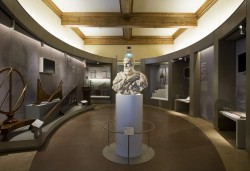 Galileo muziejus – vienas iš nedaugelio ne menui skirtų muziejų ir tikrai vertas dėmesio. Vienas iš neįprasčiausių muziejaus objektų – vidurinysis dešinės rankos pirštas. Be jo, čia eksponuojama daugybė XV-XIX amžiaus tyrinėjimų prietaisų, gaublių, stetoskopų, navigacijos įrangos, teleskopų, puikiai atspindinčių Galileo veiklą ir mokslo evoliuciją.
Galileo muziejus – vienas iš nedaugelio ne menui skirtų muziejų ir tikrai vertas dėmesio. Vienas iš neįprasčiausių muziejaus objektų – vidurinysis dešinės rankos pirštas. Be jo, čia eksponuojama daugybė XV-XIX amžiaus tyrinėjimų prietaisų, gaublių, stetoskopų, navigacijos įrangos, teleskopų, puikiai atspindinčių Galileo veiklą ir mokslo evoliuciją.
Fontana del Porcellino – Paršelio fontanas
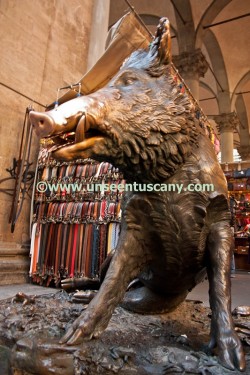 Paršelio fontanas – populiarus Florencijos atrakcionas, esantis šalia Loggia del Mercato Nuovo, einant Senojo Tilto link. Įdomu tai, kad pavadinimas netikslus, nes skulptūra vaizduoja šerną. Originą Cosimo I de Medici gavo dovanų iš popiežiaus Pio IV, jį dabar galima pamatyti Uffizi galerijoje. Bronzinė kopija buvo sukurta XVII a. pr. Sakoma, kad reikia paglostyti šernui nosį, po to įdėti į nasrus monetą ir pažiūrėti, ar ji su tekančiu vandeniu įkris pro apačioje esančias grotas, ar pakibs virš jų. Jei moneta prakrenta – pranašaujama sėkmė.
Paršelio fontanas – populiarus Florencijos atrakcionas, esantis šalia Loggia del Mercato Nuovo, einant Senojo Tilto link. Įdomu tai, kad pavadinimas netikslus, nes skulptūra vaizduoja šerną. Originą Cosimo I de Medici gavo dovanų iš popiežiaus Pio IV, jį dabar galima pamatyti Uffizi galerijoje. Bronzinė kopija buvo sukurta XVII a. pr. Sakoma, kad reikia paglostyti šernui nosį, po to įdėti į nasrus monetą ir pažiūrėti, ar ji su tekančiu vandeniu įkris pro apačioje esančias grotas, ar pakibs virš jų. Jei moneta prakrenta – pranašaujama sėkmė.
Palazzo Davanzati – Davancati rūmai
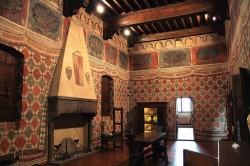 Palazzo Davanzati – tai XIV amžiaus rūmai Florencijos centre, priklausę Davizzi giminei. Jos nariai buvo žinomi kaip bankininkai ir pirkliai, pasistatę namus aikštėje, apsuptoje namų-bokštų. Dabar čia muziejus, įspūdingas savo objektais, istorija ir liudijimais apie turtingų miestiečių gyvenimą viduramžiais ir anktyvuoju renesansu. Viena iš įspūdingiausių vietų – vidinis kiemas ir terakotiniai vamzdžiai, besi leidžiantys žemyn nuo pat stogo. Tokiu būdu šeima rinko lietaus vandenį, jį nutekindavo į po rūmais esančią cisterną ir naudodavo namų ūkio reikmėms. Viduramžiais tai buvo neregėtas patogumas. Kituose rūmų aukštuose galima pamatyti svetaines, darbo kambarius, virtuvę ir virtuvinius prietaisus, tualetus ir vonią.
Palazzo Davanzati – tai XIV amžiaus rūmai Florencijos centre, priklausę Davizzi giminei. Jos nariai buvo žinomi kaip bankininkai ir pirkliai, pasistatę namus aikštėje, apsuptoje namų-bokštų. Dabar čia muziejus, įspūdingas savo objektais, istorija ir liudijimais apie turtingų miestiečių gyvenimą viduramžiais ir anktyvuoju renesansu. Viena iš įspūdingiausių vietų – vidinis kiemas ir terakotiniai vamzdžiai, besi leidžiantys žemyn nuo pat stogo. Tokiu būdu šeima rinko lietaus vandenį, jį nutekindavo į po rūmais esančią cisterną ir naudodavo namų ūkio reikmėms. Viduramžiais tai buvo neregėtas patogumas. Kituose rūmų aukštuose galima pamatyti svetaines, darbo kambarius, virtuvę ir virtuvinius prietaisus, tualetus ir vonią.
Giardino Bardini – Bardinių sodas
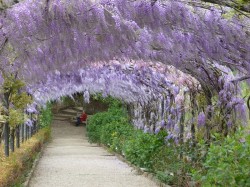 Vienas gražiausių Florencijos parkų – itališkojo renesanso stiliaus Giardino Bardini. Neseniai duris publikai atvėręs šis žalias lopinėlis dar mažai žinomams turistams, todėl – tai puiki vieta pailsėti nuo miesto triukšmo ir žmonių gausos. Nuo puikiai prižiūrėtų parko terasų atsiveria puikus vaizdas į Florenciją.
Vienas gražiausių Florencijos parkų – itališkojo renesanso stiliaus Giardino Bardini. Neseniai duris publikai atvėręs šis žalias lopinėlis dar mažai žinomams turistams, todėl – tai puiki vieta pailsėti nuo miesto triukšmo ir žmonių gausos. Nuo puikiai prižiūrėtų parko terasų atsiveria puikus vaizdas į Florenciją.
Chiesa Dante e Beatrice – Dantės ir Beatričės bažnyčia
Siaurame ir tamsoje paskendusiame skersgatvyje pasislėpusi Santa Margherita dei Cerchi bažnytėlė. Mažytė, tačiau svarbi – manoma, kad čia melstis ateidavo Dantė ir jo mūza Beatričė. Anot legendos, Dantė žaviąją Beatričę matė vos du kartus, tačiau prisiekė jai amžiną meilę ir dedikavo žymiausius savo kūrinius. Bažnytėlėje yra Beatričės kapas, o šalia jo turistai palieka raštelius su prašymais.
Chiesa di Orsanmichele – Orsamikelės bažnyčia
Vienoje pagrindinių Florencijos gatvių stovi keistas pastatas – kvadratinio plano, aukštas, pasipuošęs gotikiniais ornamentais ir šventųjų skulptūromis. Išvertus iš italų kalbos Orsanmichele reiškia šv. Mykolo sodą. Tokį pavadinimą pastatas gavo ne šiaip sau – jau nuo VIII a. šia buvo nedidelė šventyklėlė,o 1337 m. iškilo kaip šv. Mykolo vienuolyno daržas ir grūdų sandėlis ir turgus. Pirmajame aukšte vyko prekyba, antrajame įsikūrė biurai, o trečiajame – saugojami grūdai sunkiems laikams. XV a. pr. Pastatas pateko į galingų gildijų rankas ir buvo paverstas koplyčia.
Cappella Brancacci – Brankačių koplyčia
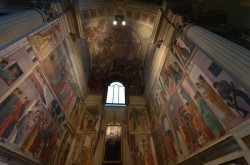 Brancacci šeimos koplyčia yra Maria del Carmine bažnyčioje, esančioje kitoje Arno upės pusėje. Ne taip dažnai turistų lankoma, tačiau labai įspūdinga – freskas joje tapė Masolino, Masaccio ir Lippi. Kartais ši koplyčia vadinama ankstyvąja Siksto koplyčia. Neveltui – žymieji renesanso sienų tapybos meistrai sukūrė milžinišką ir originalią freskų seriją, pasakojančią didžiausių pasaulio nuodėmių istoriją, epizodus iš Biblijos ir Evangelijų.
Brancacci šeimos koplyčia yra Maria del Carmine bažnyčioje, esančioje kitoje Arno upės pusėje. Ne taip dažnai turistų lankoma, tačiau labai įspūdinga – freskas joje tapė Masolino, Masaccio ir Lippi. Kartais ši koplyčia vadinama ankstyvąja Siksto koplyčia. Neveltui – žymieji renesanso sienų tapybos meistrai sukūrė milžinišką ir originalią freskų seriją, pasakojančią didžiausių pasaulio nuodėmių istoriją, epizodus iš Biblijos ir Evangelijų.
Palazzo di Bianca Cappello – Bjankos Kapelo rūmai
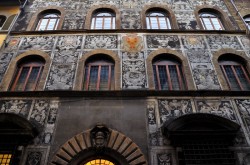 Kitoje Arno upės pusėje esantis Bianca Cappello namas traukia nelaimingų ir paslaptingų meilės istorijų gerbėjus. Gražuolė Bianca Cappello buvo kilmingo venecijiečio dukra, tapusi Toskanos didžiojo kunigaikščio Francesco I de‘Medici meiluže, vėliau ir žmona. Biancos gyvenimą nuolat lydėjo skandalai ir intrigos: kai susipažino ssu Francesco I, kunigaikštis jau buvo vedęs, tačiau tai nesutrukdė užmegzti romaną su juo. Neilgai trukus Francesco I žmona mirė paslaptingomis aplinkybėmis, o Bianca suskubo ištekėti už mylimojo. Prabėgus devyneriems metams abu mirė užmiesčio viloje. Manoma, kad jie buvo nunuodyti panaudojant aršeniką.
Kitoje Arno upės pusėje esantis Bianca Cappello namas traukia nelaimingų ir paslaptingų meilės istorijų gerbėjus. Gražuolė Bianca Cappello buvo kilmingo venecijiečio dukra, tapusi Toskanos didžiojo kunigaikščio Francesco I de‘Medici meiluže, vėliau ir žmona. Biancos gyvenimą nuolat lydėjo skandalai ir intrigos: kai susipažino ssu Francesco I, kunigaikštis jau buvo vedęs, tačiau tai nesutrukdė užmegzti romaną su juo. Neilgai trukus Francesco I žmona mirė paslaptingomis aplinkybėmis, o Bianca suskubo ištekėti už mylimojo. Prabėgus devyneriems metams abu mirė užmiesčio viloje. Manoma, kad jie buvo nunuodyti panaudojant aršeniką.
Basilica della SS. Annunziata – Švč. Anuncijatos bazilika
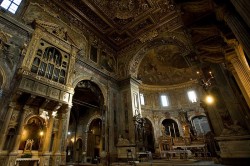 Ši iš išorės į bažnyčią visai nepanaši ir kukliai atrodanti šventovė viduje slepia tikrus lobius. Bazilika buvo pastatyta 1440 m. Viduje pribloškia tamsa ir dekoracijų gausa, čia darbavosi Alberti ir Giambologna, Andrea del Sarto ir Pontormo. Iš bažnyčios galima patekti į šalia esančio vienuolyno kiemą, vadinamą Mirusiųjų kiemu. Pasakojama legenda, kad Andrea del Sarto tapydamas freską užmigo, o jam atsibus ši buvo stebuklingai baigta.
Ši iš išorės į bažnyčią visai nepanaši ir kukliai atrodanti šventovė viduje slepia tikrus lobius. Bazilika buvo pastatyta 1440 m. Viduje pribloškia tamsa ir dekoracijų gausa, čia darbavosi Alberti ir Giambologna, Andrea del Sarto ir Pontormo. Iš bažnyčios galima patekti į šalia esančio vienuolyno kiemą, vadinamą Mirusiųjų kiemu. Pasakojama legenda, kad Andrea del Sarto tapydamas freską užmigo, o jam atsibus ši buvo stebuklingai baigta.
Basilica di San Marco – Šv. Morkaus bazilika
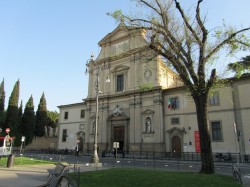 Šv. Morkaus bazilika bazilika ilgsu šimtmečius buvo milžiniško Šv. Morkaus vienuolyno komplesko dalis. Čia mokėsi ir gyveno daug žymių vienuolių – Beato Angelico, Fra Bartolomeo, Tommaso Caccini (garsus tuo, kad vadovavo Galileo Galilei teismui dėl jo tariamai skleidžiamų erezijų). Tačiau bene garsiausias iš jų Girolamo Savonarola – kelis metus valdęs Florencijos miestą, surengęs „Puikybių gaisrą“, kuriame žuvo gausybė knygų, paveikslų ir kitų prabangos objektų. Buvo sudegintas ant laužo. Dabar galima aplankyti šv. Morkaus vienuoną, pamatyti senąsias vienuolių celes, net ir tą, kurioje gyveno pats Savonarola.
Šv. Morkaus bazilika bazilika ilgsu šimtmečius buvo milžiniško Šv. Morkaus vienuolyno komplesko dalis. Čia mokėsi ir gyveno daug žymių vienuolių – Beato Angelico, Fra Bartolomeo, Tommaso Caccini (garsus tuo, kad vadovavo Galileo Galilei teismui dėl jo tariamai skleidžiamų erezijų). Tačiau bene garsiausias iš jų Girolamo Savonarola – kelis metus valdęs Florencijos miestą, surengęs „Puikybių gaisrą“, kuriame žuvo gausybė knygų, paveikslų ir kitų prabangos objektų. Buvo sudegintas ant laužo. Dabar galima aplankyti šv. Morkaus vienuoną, pamatyti senąsias vienuolių celes, net ir tą, kurioje gyveno pats Savonarola.

